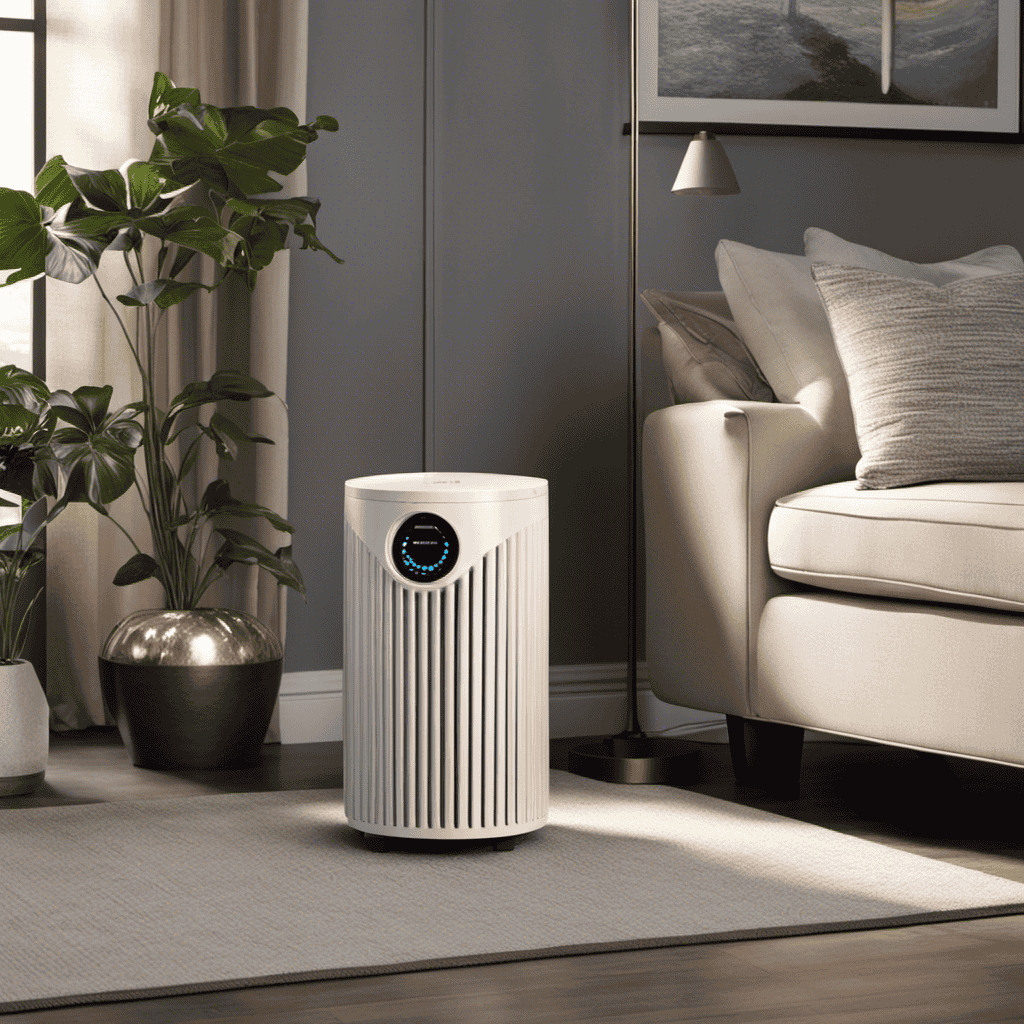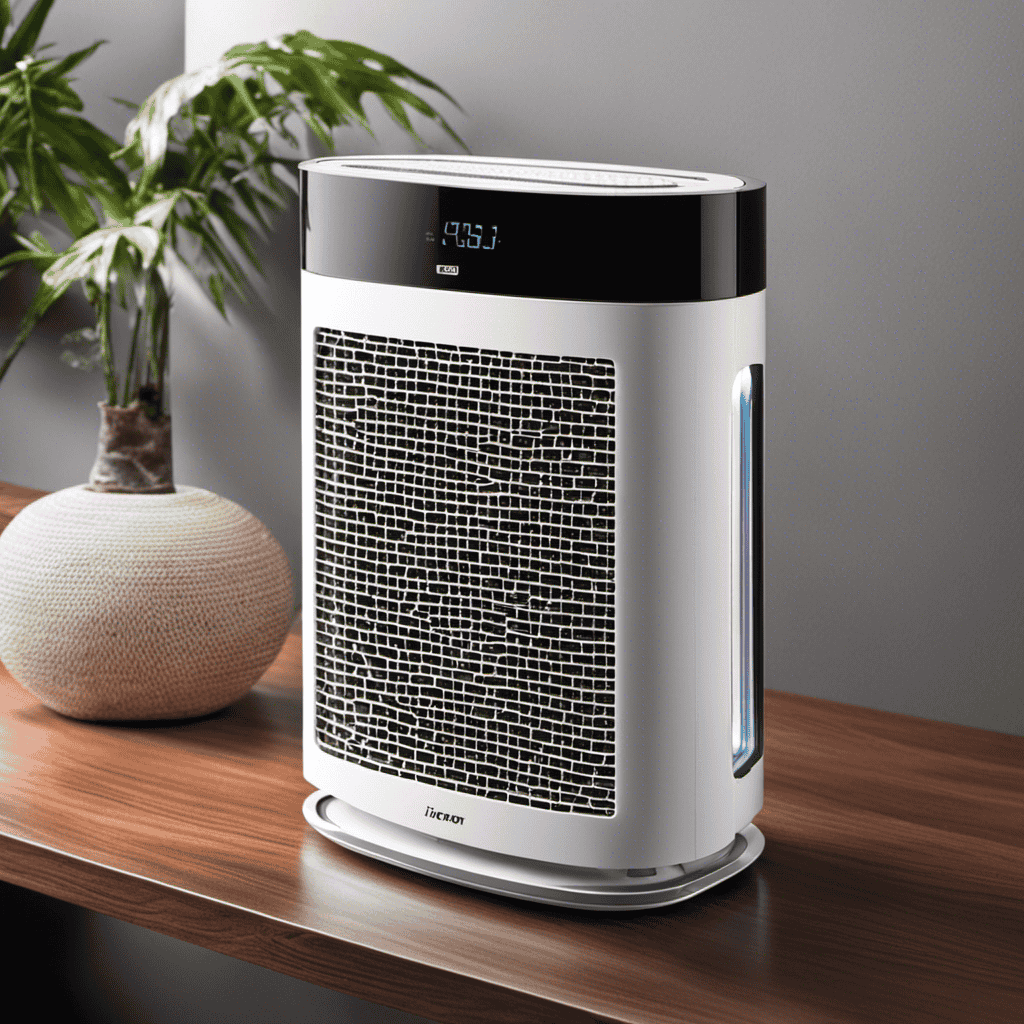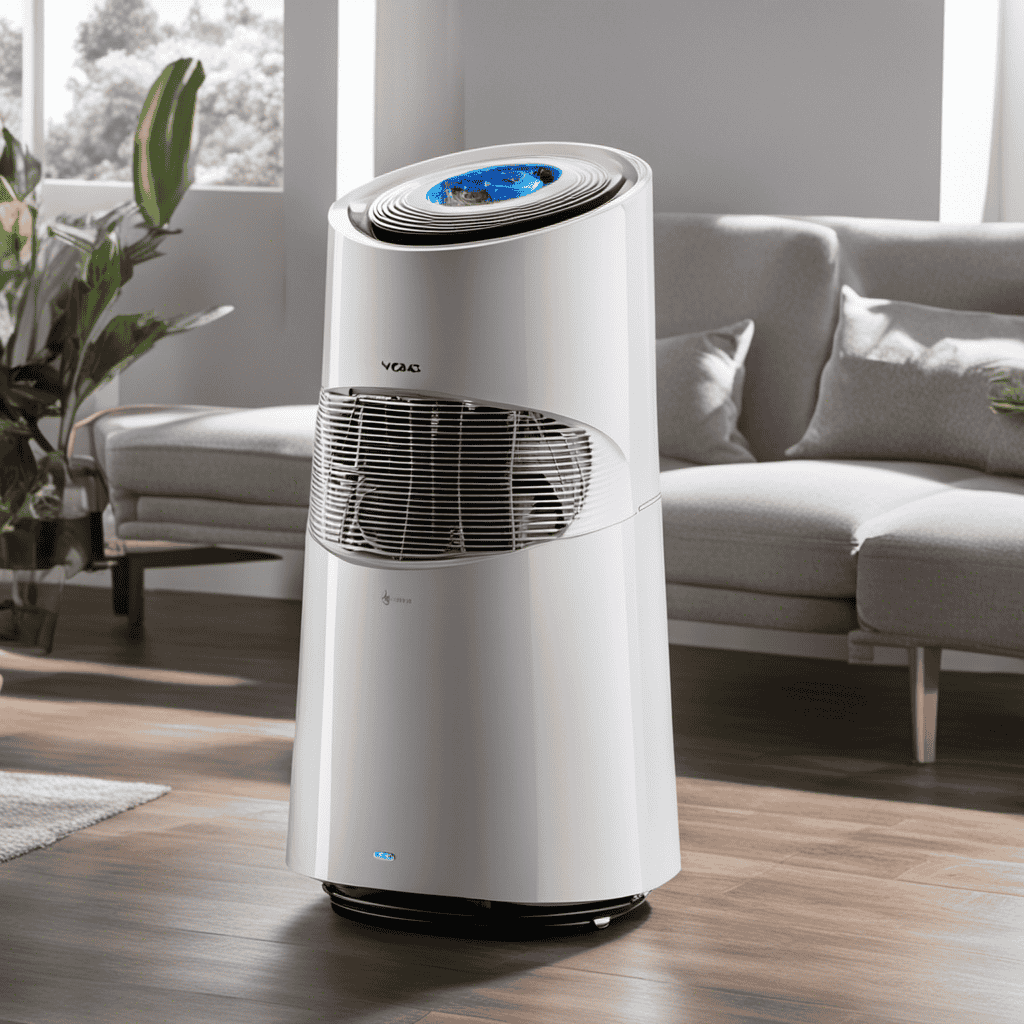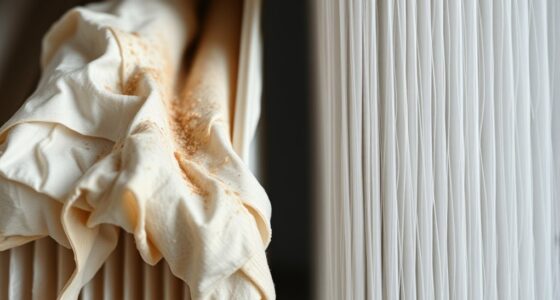Diving headfirst into the air purification scene hooks me with a big question: Just what on earth is an **ionic air purifier**?
This fascinating device harnesses the power of negative ions to eliminate harmful particles from the air we breathe.
In this article, we will explore how these purifiers work, their benefits, and the differences between ionic and HEPA purifiers.
So, join me on this scientific journey as we uncover the secrets behind these innovative machines.
Key Takeaways
- Ionic air purifiers emit negatively charged ions into the air, which attach to positively charged particles and make them too heavy to stay in the air.
- The production of negative ions by ionic air purifiers improves air quality by neutralizing harmful substances like bacteria and viruses, as well as attaching to airborne particles such as dust, pollen, and pet dander.
- Ionic air purifiers do not require filters, reducing maintenance and cost, and they also help reduce static electricity.
- Compared to HEPA air purifiers, which use physical filters to trap and remove particles, ionic air purifiers focus on reducing air pollution and improving overall air quality, while HEPA purifiers capture even the smallest particles, including allergens.
How Ionic Air Purifiers Work
Ionic air purifiers work by emitting negatively charged ions into the air, which attach to positively charged particles and remove them from the air. These devices, also known as ionizers, have been studied for their potential benefits to respiratory health. Research suggests that ionizers may help to reduce certain airborne pollutants that can trigger respiratory issues such as asthma or allergies.
One common airborne pollutant that can be a concern for many people, especially pet owners, is pet dander. Pet dander consists of tiny particles that are shed from animals’ skin, fur, or feathers, and can trigger allergic reactions in sensitive individuals. Studies have shown that ionic air purifiers can effectively remove pet dander from the air, reducing the allergenic potential in indoor environments. This makes them a popular choice for individuals with pets or allergies.
Transitioning to the subsequent section about the benefits of using an ionic air purifier, these devices not only help to improve respiratory health but also provide other advantages for indoor air quality.
Benefits of Using an Ionic Air Purifier
You’ll love the way it freshens the air in your home and helps reduce allergens.
Using an ionic air purifier has numerous benefits when it comes to improving air quality. One of the main advantages is the production of negative ions. These ions attach themselves to airborne particles, such as dust, pollen, and pet dander, causing them to become too heavy to stay in the air. As a result, they settle on surfaces and can be easily cleaned.
Negative ions also have the ability to neutralize harmful substances, such as bacteria and viruses, making the air cleaner and safer to breathe.
Additionally, ionic air purifiers do not require the use of filters, which means less maintenance and cost over time.
Common Features of Ionic Air Purifiers
When it comes to understanding the ionization process, it’s essential to explore how negative ions are beneficial.
Through ionization, air purifiers release negatively charged ions into the air. These ions attach to airborne particles, making them heavier and causing them to fall to the ground.
This process effectively removes pollutants from the air, resulting in cleaner and healthier indoor environments.
Ionization Process Explained
The ionization process in an air purifier involves releasing negatively charged ions to attract and neutralize airborne pollutants. These negatively charged ions are generated by a built-in ionizer or ionization unit.
When these ions are released into the air, they attach themselves to airborne particles such as dust, pollen, smoke, and pet dander. This process is beneficial in air purification because it helps to remove these pollutants from the air, making it cleaner and healthier to breathe.
Negative ions also have the ability to neutralize and deactivate certain types of viruses, bacteria, and mold spores. Additionally, the ionization process can help to reduce static electricity, leaving the air feeling fresher and less dry.
Overall, the ionization process in an air purifier has numerous benefits and plays a crucial role in improving indoor air quality.
Benefits of Negative Ions
One of the benefits of negative ions is that they can neutralize certain types of viruses and bacteria. Negative ions are atoms or molecules that have gained an electron, giving them a negative charge. They are naturally found in environments such as waterfalls, mountains, and forests. Research has shown that negative ions can have positive effects on mental health and sleep quality. Negative ions have been found to increase the production of serotonin, a neurotransmitter that helps regulate mood and reduce stress. They can also improve sleep quality by promoting relaxation and reducing anxiety. Additionally, negative ions can help to purify the air by attaching to and neutralizing harmful particles such as dust, pollen, and mold spores. This can lead to a cleaner and healthier indoor environment.
| Mental Health | Sleep Quality | Air Purification |
|---|---|---|
| Increases serotonin production | Promotes relaxation | Neutralizes harmful particles |
| Reduces stress and anxiety | Improves sleep quality | Purifies the air |
| Positive impact on mood | Reduces insomnia | Creates a cleaner environment |
| Improves overall mental well-being | Enhances sleep efficiency | Reduces allergies and asthma symptoms |
Differences Between Ionic and HEPA Air Purifiers
There’s a significant difference between ionic and HEPA air purifiers. While both aim to improve air quality, their mechanisms and effectiveness vary.
Ionic air purifiers use ionization technology to produce negative ions, which attach to particles in the air, causing them to become heavy and fall to the ground. This helps to reduce air pollution and improve overall air quality.
On the other hand, HEPA (High Efficiency Particulate Air) purifiers use a physical filter to trap and remove particles from the air. These filters are designed to capture even the smallest particles, including allergens, dust, and pet dander.
While both types of purifiers can be effective in improving air quality, it’s important to consider your specific needs and the size of the area you want to purify when choosing between them.
Understanding Negative Ions in Air Purifiers
Understanding how negative ions work in air purifiers can help you make an informed decision about which type of purifier is best for you.
Negative ions are molecules that have gained an extra electron, resulting in a negative charge. When these ions are released into the air by an air purifier, they attract and attach themselves to harmful particles such as dust, allergens, and bacteria. This process is known as ionization.
Once attached, the negative ions neutralize the positive charge of these particles, causing them to become heavy and fall to the ground instead of remaining suspended in the air. By removing these harmful particles, negative ions improve the overall air quality in a room, reducing the risk of respiratory issues and allergies.
Therefore, considering the benefits of negative ions in air purifiers is essential for maintaining a healthy living environment.
Types of Air Pollutants Removed by Ionic Purifiers
To make an informed decision about which type of purifier is best for you, it’s important to know the types of air pollutants that can be removed by ionic purifiers.
Ionic purifiers use negative ions to remove pollutants from the air, improving indoor air quality and reducing health risks associated with indoor air pollution. Here are some common air pollutants that can be effectively removed by ionic purifiers:
- Dust and dust mites: These microscopic particles can trigger allergies and respiratory problems.
- Pollen: Pollen from plants can cause allergic reactions, especially in individuals with pollen allergies.
- Pet dander: Tiny flakes of skin shed by pets can cause allergic reactions in sensitive individuals.
- Mold spores: Mold spores can lead to respiratory issues and worsen symptoms in individuals with asthma or allergies.
Factors to Consider When Choosing an Ionic Air Purifier
When choosing an ionic air purifier, there are several key factors to consider.
Firstly, cost vs. effectiveness is an important consideration as you want to ensure that you are getting the best value for your money.
Secondly, maintenance requirements should be taken into account as some purifiers may require frequent filter changes or cleaning, which can add to the overall cost and time commitment.
Lastly, room size compatibility is crucial as different purifiers have varying capacities and may not be suitable for larger spaces.
Cost Vs. Effectiveness
If you’re considering an ionic air purifier, you might be wondering whether the cost is worth the effectiveness. Ionic air purifiers use negative ions to remove pollutants from the air, but their efficiency can vary depending on factors such as room coverage and user reviews.
-
Room coverage: Ionic air purifiers are designed to clean specific room sizes. Before purchasing one, consider the square footage of your room and choose a purifier that can effectively cover that area.
-
User reviews: Reading reviews from other customers can provide valuable insight into the effectiveness of an ionic air purifier. Look for reviews that mention improved air quality and reduced allergy symptoms to gauge the purifier’s performance.
-
Cost: Ionic air purifiers vary in price, ranging from affordable options to more expensive models. Consider your budget and balance it with the features and effectiveness of the purifier.
-
Effectiveness: While ionic air purifiers can effectively remove certain pollutants, they may not be as effective in removing larger particles or odors. Consider your specific needs and the types of pollutants you want to eliminate before making a decision.
Maintenance Requirements
Regular maintenance is necessary to keep the ionic air purifier operating effectively. It is important to follow a maintenance schedule to ensure optimal performance.
One key aspect of maintenance is filter replacement. The filters in an ionic air purifier are responsible for capturing and removing airborne particles such as dust, pollen, and pet dander. Over time, these filters can become clogged and lose their effectiveness. Regularly replacing the filters is essential to maintain the purifier’s efficiency.
It is recommended to check the manufacturer’s guidelines for the specific maintenance schedule and filter replacement intervals for your purifier model. By adhering to the maintenance schedule and replacing filters as needed, you can ensure that your ionic air purifier continues to provide clean and fresh air.
Now, let’s explore the compatibility of these purifiers with different room sizes.
Room Size Compatibility
Determining the appropriate room size for your purifier is crucial in ensuring effective air filtration. It is important to be aware of the room size limitations of your purifier to maximize its efficiency. Here are some key points to consider when it comes to room size compatibility:
-
Air purifiers are designed to work optimally in specific room sizes.
-
Most purifiers are effective in small to medium-sized rooms, typically ranging from 100 to 300 square feet.
-
For larger rooms, it is recommended to use multiple purifiers or choose a purifier specifically designed for larger spaces.
-
The effectiveness of an air purifier in a small room is generally higher due to the smaller volume of air that needs to be filtered.
Maintenance and Cleaning Tips for Ionic Air Purifiers
For optimal performance, it’s important to regularly clean the plates of your ionic air purifier. Proper maintenance and cleaning techniques can help ensure that your air purifier continues to effectively remove pollutants from the air. Here are some tips to keep your ionic air purifier in top condition:
| Cleaning Technique | Frequency |
|---|---|
| Wipe plates with cloth | Weekly |
| Soak plates in water | Monthly |
| Use mild detergent | Every 3-6 months |
| Rinse and dry plates | After cleaning with detergent |
| Replace plates | As recommended by manufacturer |
Regularly wiping the plates with a cloth helps remove dust and debris that may accumulate. Monthly soaking in water can help remove stubborn particles. Using a mild detergent every few months can help eliminate any lingering odors. After cleaning, make sure to rinse and dry the plates thoroughly before reassembling them into the air purifier. Additionally, follow the manufacturer’s recommendations for plate replacement.
Maintaining your ionic air purifier through regular cleaning will ensure its performance and longevity. In the next section, we will explore the potential health effects of using ionic air purifiers.
Potential Health Effects of Using Ionic Air Purifiers
Using an ionic air purifier can have potential health effects that should be considered. While these devices are designed to improve indoor air quality, studies have raised concerns about their long-term risks. It is important to understand the potential health effects associated with ionic air purifiers before using them:
-
Ozone production: Ionic air purifiers generate ozone, which can irritate the respiratory system and worsen symptoms in individuals with asthma or other respiratory conditions.
-
Lung irritation: The charged particles emitted by these purifiers can irritate the lungs, leading to coughing, wheezing, and shortness of breath.
-
Negative ion exposure: High levels of negative ions in the air may have adverse health effects, including headache, fatigue, and difficulty concentrating.
-
Limited effectiveness: Some studies suggest that ionic air purifiers may not effectively remove certain pollutants, such as allergens and fine particles.
To mitigate potential risks, it is crucial to follow manufacturer guidelines and consider alternative air purification methods. Further research is needed to better understand the long-term health effects of using ionic air purifiers.
Ionic Air Purifiers and Allergies: What You Need to Know
When it comes to allergy relief, ionizers have been touted as a potential solution. These devices claim to remove allergens from the air, providing a cleaner and healthier environment.
But do they really work, and what are the potential health benefits? In this discussion, we will explore the effectiveness of ionizers in providing allergy relief and examine the potential health benefits associated with their use.
Allergy Relief With Ionizers
Ionizers can provide relief from allergies. They work by releasing negative ions into the air, which bind with allergens and remove them from the environment. This can be particularly beneficial for individuals who suffer from allergies caused by pet dander.
Here are some key points to consider about the relationship between ionizers and allergy relief:
-
Negative ions: Ionizers release negative ions, which are able to attach themselves to allergens such as pet dander, pollen, and dust mites.
-
Sleep quality: The presence of negative ions in the air has been shown to improve sleep quality. This can be especially helpful for individuals with allergies, as better sleep can lead to reduced symptoms.
-
Pet dander removal: Ionizers can effectively remove pet dander from the air, reducing the allergens that can trigger allergic reactions.
-
Enhanced air purification: In addition to removing allergens, ionizers also help to eliminate other pollutants and odors from the air, creating a cleaner and healthier environment.
Potential Health Benefits
One potential health benefit of ionizers is that they can help alleviate symptoms of respiratory conditions like asthma. Ionized air, produced by ionic air purifiers, contains charged particles that can attach to airborne allergens and pollutants, making them heavier and causing them to fall out of the air. This can reduce the presence of irritants that can trigger asthma symptoms, such as dust, pollen, and pet dander.
By improving indoor air quality, ionizers may also have a positive impact on mental health. Studies have suggested that exposure to clean air can improve mood, reduce stress, and enhance cognitive function.
However, it is important to note that ionizers produce ozone as a byproduct, which can be harmful in high concentrations. Therefore, it is crucial to use ionizers in a well-ventilated space and follow manufacturer guidelines for safe usage.
Noise Levels of Ionic Air Purifiers
The noise levels of ionic air purifiers can vary depending on the model and settings. Some purifiers are designed to operate silently, while others may produce more noticeable noise. Manufacturers have incorporated various noise reduction techniques to minimize the sound generated by these devices.
Here are a few factors that contribute to the noise levels of ionic air purifiers:
- Fan speed: Higher fan speeds can result in increased noise output.
- Design: The design of the air purifier, including the airflow path and the materials used, can affect noise levels.
- Filters: The type and condition of the filters can influence the noise produced by the purifier.
- Settings: Adjusting the settings, such as fan speed or operating mode, can impact the noise levels.
Considering the noise levels is important for individuals seeking a quieter operation.
Now let’s move on to discuss the energy efficiency of ionic air purifiers.
Energy Efficiency of Ionic Air Purifiers
When considering the energy efficiency of ionic air purifiers, three key points to analyze are power consumption comparison, long-term cost analysis, and environmental impact assessment.
Power consumption comparison involves looking at how much electricity each type of air purifier consumes and determining which one is more energy-efficient.
Long-term cost analysis evaluates the overall expenses associated with operating and maintaining an ionic air purifier over an extended period of time.
Lastly, an environmental impact assessment examines the ecological consequences of using an ionic air purifier, such as the emission of ozone or other harmful byproducts.
Power Consumption Comparison
To compare power consumption, you can look at how much electricity different ionic air purifiers use. This power consumption analysis is important because it helps determine the energy efficiency of the purifier and its impact on your electricity bill.
When comparing the power consumption of different ionic air purifiers, consider the following factors:
-
Energy saving features: Some purifiers have features like auto shut-off or sleep mode, which reduce power consumption when the air quality is good or during periods of inactivity.
-
Wattage: Look at the wattage rating of each purifier to see how much electricity it consumes. Lower wattage generally means lower power consumption.
-
Fan speed settings: Purifiers with adjustable fan speed settings allow you to customize the power consumption based on your needs. Lower fan speeds typically consume less power.
-
Overall design: Compact and well-designed purifiers often have optimized power consumption, as they are built with energy efficiency in mind.
Long-Term Cost Analysis
Consider the long-term cost analysis of different models to determine which one is the most cost-effective for you. When comparing the long-term cost of different air purifier models, it is important to consider not only the initial purchase price but also the cost of maintenance and replacement parts.
Some models may have a lower upfront cost but require frequent filter replacements, resulting in higher long-term expenses. Additionally, it is crucial to consider the environmental sustainability of the air purifier. Look for models that are energy-efficient and have eco-friendly filter options.
By choosing an air purifier that is both cost-effective and environmentally sustainable, you can ensure clean air for your home while minimizing your impact on the environment.
Now, let’s delve into the next section about the environmental impact assessment.
Environmental Impact Assessment
To assess the environmental impact of your chosen model, you should research factors such as energy consumption, filter disposal, and manufacturing processes. Conducting an environmental impact assessment is crucial in understanding the potential consequences of using an ionic air purifier.
Here are some key points to consider:
-
Energy Consumption: Look for models that are energy-efficient, as they consume less electricity and have a smaller carbon footprint.
-
Filter Disposal: Find out how the filters are disposed of once they are no longer effective. Look for models that offer easy and eco-friendly filter replacement options.
-
Manufacturing Processes: Research the manufacturing processes involved in producing the air purifier. Look for companies that prioritize sustainable and environmentally friendly practices.
-
Potential Health Effects: Consider any potential health effects associated with the ionic air purifier, such as ozone emissions. Look for models that have been tested and certified to meet safety standards.
Ionic Air Purifiers for Large Spaces
Looking to purify the air in a large space? Ionic air purifiers are a great option for you!
When it comes to room size compatibility, these purifiers are designed to effectively clean the air in larger areas, such as living rooms, offices, or open-concept spaces. They have a higher airflow capacity and can cover a larger square footage compared to smaller units.
As for noise levels, it’s important to consider the decibel rating of the purifier. Ionic air purifiers generally operate silently, making them suitable for use in bedrooms or quiet areas. However, it’s always a good idea to check the product specifications to ensure that the noise level is within your desired range.
Overall, ionic air purifiers offer a practical solution for purifying the air in larger spaces while maintaining a peaceful environment.
Ionic Air Purifiers Vs. Ozone Generators: What’s the Difference
When deciding between an ionic air purifier and an ozone generator, it’s important to understand the key differences. Here are some points to consider:
- Ozone generators produce ozone gas, which can be harmful to humans and pets when inhaled in high concentrations.
- Ionic air purifiers use ionization technology to charge particles in the air, causing them to stick to surfaces or be collected in a filter.
Ozone generators are typically used for odor elimination and disinfection purposes. Ionic air purifiers are effective at removing airborne particles, such as dust, pollen, and pet dander.
When it comes to ozone generators vs. UV air purifiers, it’s important to weigh the potential risks associated with ozone gas against the effectiveness of ionization technology in removing airborne particles. Consider your specific needs and concerns before making a decision.
Ionic Air Purifiers and Odor Elimination: How Effective Are They?
If you want to eliminate odors in your home, ionizers can be quite effective. These devices, also known as ionic air purifiers, work by releasing negatively charged ions into the air. These ions attach themselves to positively charged particles, such as dust, pollen, and pet dander, causing them to become heavy and fall to the ground. This process helps to remove these particles from the air, reducing odors and improving air quality.
But how effective are ionic air purifiers specifically on pet odors? To answer this question, let’s take a look at the table below:
| Ionic Air Purifiers and Pet Odors |
|---|
| Pros |
| – Removes pet dander and hair |
| – Reduces pet odors |
| – Improves overall air quality |
| ———————————- |
| Cons |
| – May not completely eliminate |
| strong pet odors |
| – Regular cleaning of pet areas |
| still necessary |
While ionic air purifiers can be helpful in reducing pet odors, they may not completely eliminate strong odors. Regular cleaning of pet areas is still necessary to maintain a fresh-smelling home.
Frequently Asked Questions
Can Ionic Air Purifiers Effectively Remove Pet Dander and Pet Odors From the Air?
Ionic air purifiers are effective at removing pet dander and odors from the air. They use negatively charged ions to attract and trap particles, including pollen and allergens. Compared to HEPA filters, they provide a viable alternative for pet dander removal.
Are Ionic Air Purifiers Safe to Use Around Children and Pets?
Around children and pets, safety is paramount. Ionic air purifiers may pose potential health risks due to the emission of ozone. Other types of air purifiers, like HEPA filters, are effective and safer alternatives.
Do Ionic Air Purifiers Produce Any Harmful Byproducts or Ozone?
Ionic air purifiers can produce harmful byproducts, such as ozone. It is important to consider the potential health risks associated with ozone production before using an ionic air purifier in your home.
How Often Do the Filters in Ionic Air Purifiers Need to Be Replaced?
Filters in ionic air purifiers need replacing less frequently than traditional filters. The cost of replacement filters can vary, but the benefits of using an ionic air purifier, such as improved air quality, make it worthwhile.
Can Ionic Air Purifiers Eliminate Smoke and Cigarette Odors From the Air?
Yes, ionic air purifiers can eliminate smoke and cigarette odors from the air. They use negatively charged ions to attract and remove particles, including smoke and odors. They are also effective in removing mold spores and allergens.
What are the benefits of using an Ionic Air Purifier with a fan compared to a regular Ionic Air Purifier?
An ionic air purifier fan offers the benefit of more efficient air circulation compared to a regular ionic air purifier. The built-in fan helps to push air through the filter, enhancing the purifying process and providing cleaner air in a larger area.
Conclusion
After learning about the science behind ionic air purifiers, it is clear that these devices offer numerous benefits for improving indoor air quality.
Their ability to generate negative ions and remove pollutants is truly impressive.
While they may not be as effective as HEPA filters in capturing larger particles, their energy efficiency and ability to eliminate odors make them a viable option for many households.
So next time you’re looking to freshen up your living space, consider giving an ionic air purifier a try.
You’ll be amazed at the difference it can make!










